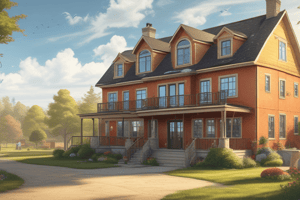Podcast
Questions and Answers
What is the primary concern of the protected volume in a building?
What is the primary concern of the protected volume in a building?
Cold bridges in insulation can help retain heat within a building.
Cold bridges in insulation can help retain heat within a building.
False
What is the significance of the U-value in building insulation?
What is the significance of the U-value in building insulation?
It measures the overall heat transfer coefficient through a wall.
A __________ is essential to prevent heat loss around windows and doors.
A __________ is essential to prevent heat loss around windows and doors.
Signup and view all the answers
Match the following energy efficiency levels with their corresponding ratings:
Match the following energy efficiency levels with their corresponding ratings:
Signup and view all the answers
Which of the following is NOT a preventive measure against condensation?
Which of the following is NOT a preventive measure against condensation?
Signup and view all the answers
The S-peil energy efficiency rating has replaced the K-peil rating.
The S-peil energy efficiency rating has replaced the K-peil rating.
Signup and view all the answers
What are cold surfaces often a cause of in a building?
What are cold surfaces often a cause of in a building?
Signup and view all the answers
The Flemish government sets a maximum allowable __________ for insulation materials.
The Flemish government sets a maximum allowable __________ for insulation materials.
Signup and view all the answers
What does a lower thermal conductivity (λ) value indicate?
What does a lower thermal conductivity (λ) value indicate?
Signup and view all the answers
Study Notes
Protected Volume
- A protected volume is a space that is not heated, but is next to a heated room
- The insulated area must be well isolated from adjoining heated rooms
- A cold bridge occurs when a heated room transitions to a non-heated room, potentially leading to heat loss
- Example of a cold bridge: a non-heated garage attached to a house
Insulation
- Insulation is crucial for maintaining the temperature difference between heated and non-heated sections.
- If poorly insulated, cold air will enter the non-heated section, leading to wasted energy and problems in the heated area.
Energy Efficiency
- The document details various energy efficiency levels (e.g., K33, K45) for different types of buildings (e.g., low-energy homes, passive homes).
- Higher K-values represent better insulation
- Example: A passive home has a K-value of 00
U-value
- U-values relate to the amount of heat transferred through a material or structure.
- Lower U-values are ideal as they indicate less heat transfer.
- U-values determine maximum heat transfer rates per unit of area (e.g., 0.24 W/m²K)
Windows and Glazing
- Double-glazing in windows is a good practice for low-energy homes as it significantly improves thermal efficiency compared to single-glazing.
Studying That Suits You
Use AI to generate personalized quizzes and flashcards to suit your learning preferences.
Description
This quiz explores key concepts related to building insulation, energy efficiency, and the implications of protected volumes. You'll learn about U-values, K-values, and the importance of proper insulation to maintain energy efficiency in buildings. Test your knowledge on how insulation affects heat transfer and energy conservation.




